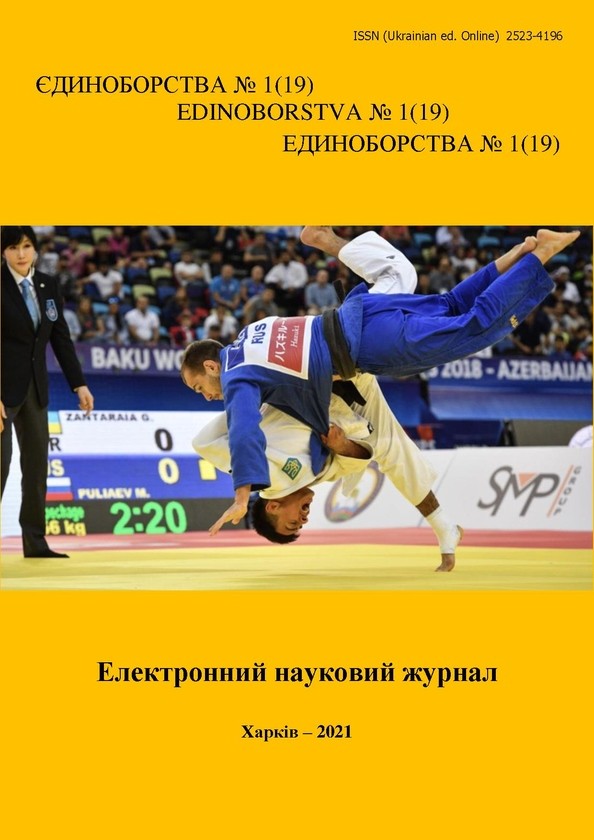Features of the organization of the educational process in fencing in Ukraine and China
DOI:
https://doi.org/10.15391/ed.2021-1.04Keywords:
fencing, epee fencers, training, preparation, Ukraine, ChinaAbstract
Purpose: to study the systems of training fencers in China and Ukraine Material and methods. The study involved 24 epee fencers 15-19 years old from Ukraine (n=12), members of the men's national teams of the Kharkov region and Ukraine, who train at the sports complex «Unifecht» (Kharkov, Ukraine) and China (n=12), members of the men's national team of Fujian province of the People's Republic of China (Fuzhou, China). The study lasted 12 months, from September 2019 to September 2020. Research methods: analysis of scientific and methodological literature, analysis of scientific and methodological literature, questionnaires, pedagogical observation, pedagogical testing, the method of expert assessments, methods of mathematical statistics. Results: the problems and peculiarities of the organization of scientific and technological progress in two countries are considered, which makes it possible to better understand the ways of improving work with fencers in order to obtain the maximum result and increase the effectiveness of athletes' performances at competitions. The questionnaire, testing of the levels of physical and technical-tactical readiness of epee fencers was carried out. Conclusions. The analysis of special literature shows that both countries have a state-forming vertical of power, which directs, directs, finances and supports the sphere of physical culture and sports. Ukrainian epee fighters pay more attention to independent work, work in pairs three times a week, perform more varied and unexpected combat actions. The analysis of the results of the general physical readiness of fencers from both countries proves that the level in both groups is quite high. There were no significant differences, except for the test «Lifting the trunk to the sitting position in 1 minute» (p<0,05). Under the influence of training programs, athletes tended to improve their results. The Chinese epee fencers showed the best ability to quickly recover from the competition. An analysis of the arsenal of military operations allows us to assert that the scientific and technical progress in China is highly specialized, and in Ukraine there is a principle of complete mastery of knowledge, skills and abilities of fencing. Practical recommendations are given.
References
Бріскін, Ю., Семеряк, З., & Пітин, М. (2014). Результативно-значущі техніко-тактичні дії фехтувальників-шпажистів різної кваліфікації. Фізична культура, спорт та здоров’я нації: зб. наук. праць, Вип. 18, Т.2, 37-43.
Бусол, В. А. (2014). Фехтування. Навчальна програма для ДЮСШ, СДЮШОР, ШВСМ та спеціалізованих навчальних закладів спортивного профілю. Київ, 50 с.
Бусол, В., & Дьоміна, О. (2013). Фехтування в Україні: історія та сучасний стан: навч. посіб. Київ, 72 с.
Дрюков, В. (2013). Фізична підготовка фехтувальників-шаблістів на етапі попередньої базової підготовки. Спортивна наука України, (2), 35-38.
Наказ Міністерства молоді та спорту України «Про затвердження тестів і нормативів для проведення щорічного оцінювання фізичної підготовленості населення України» від 15.12.2016, № 4665. https://zakon.rada.gov.ua/laws/show/z0195-17/Text
Семеряк, З. (2014). Взаємозв’язки показників підготовленості фехтувальників-шпажистів різної кваліфікації. Спортивна наука України, № 4 (62), 40-46.
Трушникова, Г. Я. (2010). Подбор средств и методов для решения задач тренировки силовых, координационных и скоростных способностей в фехтованиии [Электронний ресурс]. Режим доступа: http://www. dushlobnya. ru/metodrabota. html (дата обращения: 12. 02. 2010).
Digel, H., Miao, J. & Utz, A. (2003). Hochleistungssport in China. Weilheim / Teck: Brauer.
Miao, J. (2006). Die Sportwissenschaft in China. China Journal. Sport und Gesellschaft in China, O. J. (1), 21-25.
Sloboda, H. (2006). Kind und Athlet sein in China. Talentsuche und -forderung auf Chinesisch. China Journal. Sport und Gesellschaft in China, o. J. (2), 22-25.
Voigt, B. (2008). China trainiert für Olympia. Das Sportsystem im Reich der Mitte. Zugriff am 10. Mai 2013 unter http://www.bpb.de/internationales/asien/china/4423/das-sportsystem-im-reich-der-mitte.













